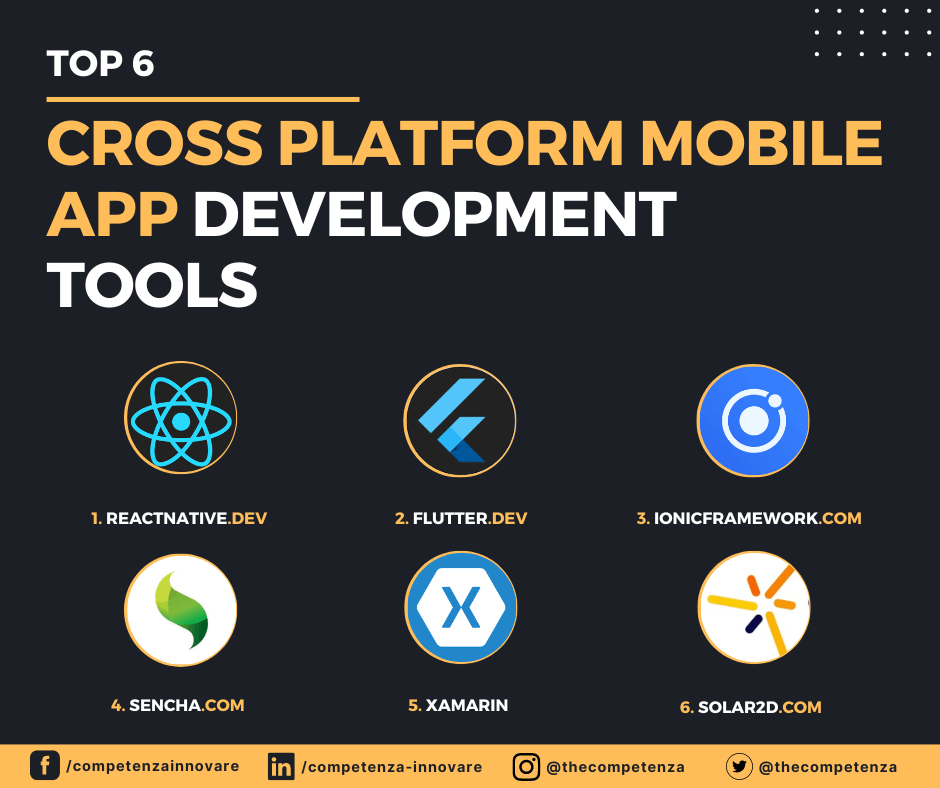Creating mobile applications to boost productivity within a time frame can be challenging for app developers; that’s why software development companies have developed tools/frameworks that can create apps to simplify the whole smartphone app development process.
App makers are looking for cross-device app development tools in a very competitive market, and businesses are looking for ways to make more money. The process of making cross-mobile apps takes a lot of time and resources.
Thanks to some popular cross-platform mobile application creators that have gained centre stage to work on multiple platforms, including Android, Blackberry, Windows Phone, iOS, and many more.
To give you an idea of what these frameworks are like, I’ve put together a list of the best cross-platform development tools that use the newest technology.
1. React Native
React Native is an open-source cross-platform app creation tool made by Meta Platforms, Inc. It was launched in 2015. Mobile apps can be made for Android, iOS, macOS, Windows, the web, tvOS, and other systems.
React Native uses JavaScript to build hybrid mobile apps with true native capabilities. Because of this, React Native is one of the most popular frameworks used by thousands of mobile app developers. You can then use that code on various devices without having to rewrite the whole app. It saves time and makes sure that performance is always the same.
Features – Native look and feel, Code Reusability, cost-efficient
2. Flutter
Flutter is an open-source best cross platform app development tool made by the tech giant Google. It came out in 2017, about two years after React Native.
With Flutter you can develop hybrid apps for Android, iOS, Windows, macOS, etc. To develop apps with Flutter, you have to use a programming language called Dart.
46% of software workers around the world choose Flutter as their cross-platform app development software for the mobile framework of choice. Because of this, companies that want a flexible and effective way to make apps should think about the framework’s many benefits.
Features – Less code development time, Own rendering engine, Platform-Specific Logic Implementation
???? You Must Also Read: Pros and Cons of Cross Platform App Development
3. Ionic
Ionic is an open-source framework that comes with a set of native components and platform-specific UL elements. For making apps, it uses front-end tools like Angular, JavaScript, and CSS. It works with HTML5, but you need a shell-like Cordova or Phone Gap to make it local.
Developers have the flexibility to access more than a hundred design and functional elements with various components and plugins. The mobile development lifecycle can quickly create powerful apps for iOS, Android, Electron, and PWA. It provides pre-designed components, interactive paradigms, extensive themes, and typography.
Features – Javascript components, Framework compatibility, mobile-optimized UI components.
4. Sencha
Sencha allows you to build apps with modern Java and JavaScript frameworks. With about 115+ fully supported and tested UI components, you can easily integrate them into your app. Developers use HTML5 for creating apps and convert them to other platforms with Adobe PhoneGap. Developers can make apps for iOS, Windows, Blackberry, and Android by deploying a single script. It makes apps more interesting and easy to use by adding features like fluid movements, flexible layouts, and smooth scrolling.
It is up to the platform to make sure that all platform apps have the same overall look. It comes with UI tools, toolbars, forms, menus, lists, and more that work very well. You can also use design tools and make styles that can be used again and again without having to add a lot of code.
Features – Code compatibility of new with an old library of prebuilt UI components, custom modules.
5. Xamarin
One of the leading solutions for native cross-platform application development allows developers to use a single C# codebase for Android, iOS, and Windows. Xamarin gives you the flexibility to add components directly from an interface, native API access, integration with backends, interfaces for sharing code, and much more. Developers can use the language, APIs, and IDE anywhere. Developers can use up to 70% of the code they write for one platform on another if the features they use are good.
Features – Single technological stack, simplified maintenance, time, and cost-saving.
6. Solar 2D (Formerly Corona)
Solar 2D is a cross platform development tools that let you make 2D games and apps that run on multiple platforms. It is a powerful multimedia development tool that came out in 2009 with open GL hardware acceleration for graphics and motion. It includes more than 1000 apps and plugins that make it easy for developers. Paired with IDE, it changes code instantly and provides a real-time preview of your app.
Because Lua language scripts are small and powerful, the apps are designed to run faster. It’s a free tool that’s mostly used for 2D games and works with HD images and fast development games. No matter, if you are a pro or novice app developer, the entry-level of development, allows you to access the core functionality of the framework.
7. Node.Js
Node.js is an open-source JavaScript processing environment that works on Windows, Linux, Unix, macOS, and other operating systems. JavaScript code can be run outside of a web browser with Node.js and the V8 JavaScript engine. Developers can use JavaScript to write command line tools and scripts that run on the server with Node.js.
Features – Asynchronous and Event-Driven, Single-Threaded, Scalable
Wrapping Up
Today, businesses face tough competition, and it has been imperative to provide top-notch technology for smooth performance. Cross mobile app development offers server advantages, including budget reduction, less time, and the possibility to expand the targeted audience outreach. Over time, the benefit of cross platform mobile development tools spreads and leads to more development.








